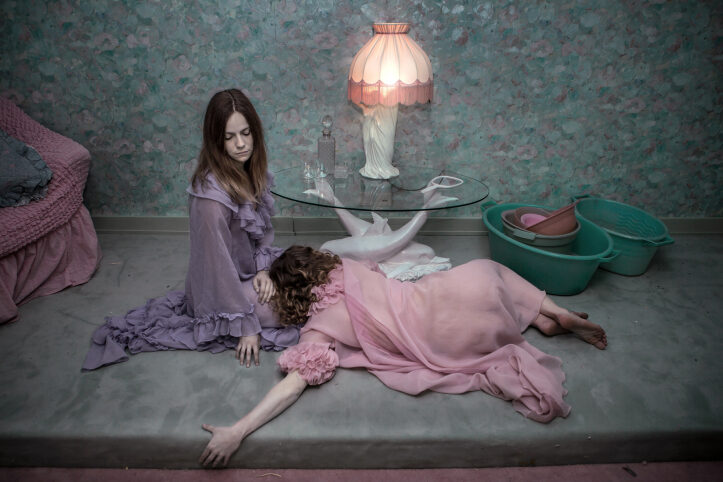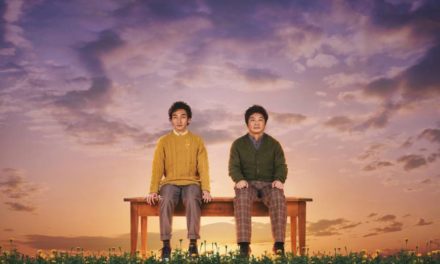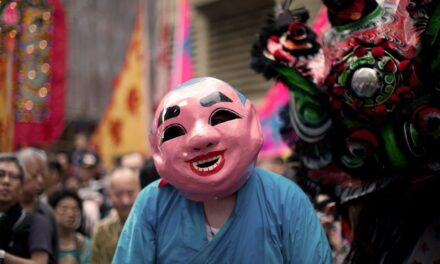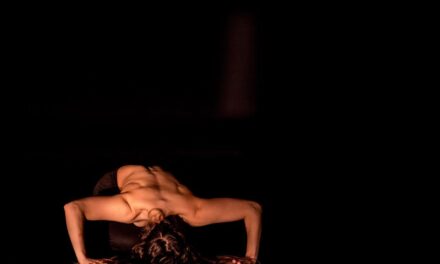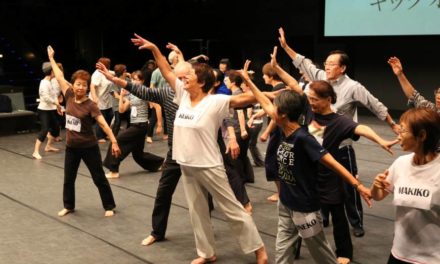Signa and Arthur Köstler are the creative directors of SIGNA, the well-known performance installation company. Their latest performance, Das Heuvolk, took place near Mannheim in Benjamin Franklin Village during the bi-annual Schillertage Festival organized by the National Theatre of Mannheim. Their productions are famous for taking place in big houses for approximately one month, and by their site-specific characteristics, they can create a sense of being in a parallel universe, where their audience can wonder around from room to room for a whole evening. During this time they can chat with the numerous cast of actors, find out the rules of their system, eat, drink and get immersed in their world. Here, the audience had the chance to spend 6 hours with a sect whose members are Himmelfahrers (Ascensioners, those who can go to heaven) and whose leader died not long ago. Their daily life is busy: they are continually making rituals to incorporate their gods. According to their mythology they already found ten out of twelve gods and in order to find all of them before the world is ending, they are struggling in different means to search for the remaining two. If they find them in time, they won’t burn like “the rest” (“Heuvolk” meaning “Straw People”, those who are not initiated into this cult). Meanwhile, they are also looking for new members for their sect, so they are very happy to have visitors (audience) as some of them might turn out to be chosen Himmelfahrers. At the end, each participant can choose whether he felt the calling or not to join. A conversation with Arthur Köstler (artistic co-director and performer) about their work, similarities with video games, and about faith.
Arthur Köstler: Did you read the Frequently Asked Question section on our webpage?
Ágnes Bakk: I have to admit I haven’t.
OK. I’ll tell you when you ask something.
Thanks. How would you name the genre of your productions?
We don’t call it anything, usually other people name it. When Signa started in 2001 she was making installation art pulling other people into it so it became referred to as “performance installation” and theatres started to invite us. Suddenly we were named “interactive theatre” and now “immersive theatre.” I don’t even know what immersive theatre is supposed to be. A book can be just as immersive and an immersive theatre show can be totally not immersive. It is just a term for selling something.

Arthur Köstler in Das Heuvolk, from SIGNA. Photo credits: Erich Goldmann.
It is also a term for theorists to get busy with. Theorists like me.
It is true, you can write about it. It is just a word, but we take whatever is there. And although some people want to call it “immersive theatre” we don’t like that, we name it rather “performance installation.”
What does it mean for you to play, to perform?
It means where the hard work pays off but also where everything starts. Our production needs a lot of preparation and we are telling all our colleagues, for example, those who build the set, that they should also perform. We find a role for them. They don’t have to be actors, they can be a picture somewhere. Playing is where actually everything starts. If the set designers would stop when we start to perform, it would mean for them that they can’t taste the fruits of their work. I don’t really want to see our performance as a game. A game is supposed to be fun. But this is not supposed to be fun. It is also hard to capture the audience’s attention, to manipulate them into the fiction. There are a lot of things we performers have to do, that keep our feet on the ground and don’t allow us to lift off. The show would be totally crap if we just lifted off. For the audience this is not supposed to be just an entertainment, it should reach some kind of depth. I can see people sometimes crying, having a hard time, or getting angry. Sometimes they even have to leave because it’s too much. In this way, I don’t think it is a game.
Have you ever played video games?
I don’t really play video games. But we collaborated with a video game company PlayDead, that is based in Copenhagen. They made two games: Limbo and Inside. For Inside, we worked with their main sound designer, with whom we worked for many years on a show. After the first video game, he needed a human sound, and he thought if anybody can make realistic human sounds then it must be us. Limbo is actually a platform puzzle: it is about a boy who wakes up and walks through some industrial and forest environments. At one point, a boy melts together with a blob of 50 bodies. You have to control this blob and this blob makes all kind of human noises. We made some audio sessions that were really really hard with 5 people sitting on each other, falling down etc. We were nominated for the best performance in video game award show in the UK.
Don’t you see similarities between your immersive performance installations and video games?
Of course, in some ways. But it is also very different. In a video game, you just sit and it is all virtual. That is a big difference. It is like reading a book about a country and then going to that country. It’s similar but also very different.

Signa Köstler in Wir Hunde/Us Dogs in 2016. Photo credits: Erich Goldmann.
But in SIGNA’s case, you also enter a territory that is a virtual world. For the second time when I participated at Das Heuvolk, I realized there are small rules that I have to play along with. Each room has its own rules but in the end, it is your choice whether you become a “Himmelfahrer”. And if you choose to be a Himmelfahrer, there is also a danger that you get so addicted to this community that you will come back (As some audience members did already). It’s like a game that gets you addicted.
Yes, and you can get even more into it. First of all, in this show, it is impossible to visit every room in one evening. There was a man who kept coming back for 10 times to our previous show and he is already for the third time participating in this one (the interview was made on the 23rd of July, the performance series started on the 16th of June), but he just managed to get to all rooms. But also after this point, you can start to get deeper into all the relationships between the Himmelfahrers. The more you get there, the more you get involved. You can also befriend some of the characters. Of course, at some point, this escalation will stop, but we improvise.
What are the fixed points which none of the actors can overstep?
One fixed point here is that everybody must be a Himmelfahrer. There can’t be someone with doubts about it or about Jake Wolcott (the founder of the sect).
But your character, the Cowboy, one of the oldest friends of the founder, is a bit doubtful.
My character would never doubt Jake Wolcott. He sees every day that he was right, but he doubted the strength of the others. I worry about brothers that don’t have the guts, and maybe will not survive. But never Jake Wolcott.
Not even at the last performance?
No, as in the last performance there will be a lot of people who will be there for the first time. It wouldn’t make sense for them at all. When we make a show that is 24/7 or for 10 days, then it can be that we have some sort of finale, where for example everybody dies. But not in a show which is constructed on a daily basis. There are new people every day.
I want to quickly revisit video games. How can you name the things that are similar to a video game in your show?
First of all, you also have to make a distinction what kind of video games are we talking about now. Our productions are not a platform puzzle game but more like Grand Theft Auto, GTA, (open-world freedom, storytelling, mission-based game) in a way. You kind of have the whole world where you can move around. In every game, you have a task but you don’t have that in our shows, so you can’t achieve anything. Maybe there might be video games with the same concept, but the point of a video game is to make the player achieve something. Actually, Playdead made a video game without any point. Second: nothing real can happen to you in a video game. Yet. In our shows, you cannot die but you can be more emotional, as you are personally involved and you are physically there. You are much more vulnerable. You can be the most evil asshole in GTA who pushes people off a mountain but you wouldn’t do it here. Even if you weren’t going to be violent (which we wouldn’t allow), sometimes there are possibilities to become really evil without violence, but even then people don’t do that or just very few. They keep to their moral code, much more than in a video game.
So you say people are not really breaching their boundaries?
They sometimes do but in both directions. Sometimes they do things which they regret afterward, they tell us: “I would never have thought that I would do this” or “I was surprised about myself that I would react like that”.
Are there also some people who came to participate in a “lunapark” like an experience chaser?
Of course – sometimes there are people who took some pills before they came, as they like the show when they’re high. There are some people who are afraid and drink beforehand. A little bit of alcohol is good for that show. But I haven’t really felt that many of the people are in too much of a lunapark–type situation. If someone seems to be too amused we try to find a way to drag them further into deeper layers of the performance. But then it depends on the actor and the situation.
How do you train your actors?
We have a five-week workshop where we talk a lot. We have a mixture of old and new actors and we tell them about the basics of how our shows work. Then we build the characters that can play together, and we test it. Once we start playing, it kicks off, real things start happening. Everything else before is theory and in la lot of cases you don’t use much of what you prepared.
Are you sometimes surprised what the other actors are performing?
Yes of course. This is what I enjoy the most – to see the ideas of other actors. That is what I think everybody likes – to see that when it works perfectly, it’s like magic. It couldn’t have been written better. I enjoy it very much when I see my fellow actors.
There is also a speaker in every room?
Not really a speaker, but a surface vibration transducer is mounted on the windows. We don’t like a sound installation that comes from hidden speakers that could be discovered by the audience. But the composer we work with now has introduced us to this audio transducer. It works like a loudspeaker, but if you put it on a hard surface the surface becomes the loudspeaker. We have a subwoofer, to give some depth, which sometimes we build into the floor under the carpet. To distribute the sound we also have a pirate radio station that saved us a lot of cable work.
Are you considering later using more new tech tools in your performances?
I don’t like tech to be exposed. I don’t do technology for the sake of technology. Actually, I like LO-FI much more also because of the budget. I like things that I can build myself and I like cheap solutions – for everything. We don’t like to spend a lot of money on anything we can’t reuse later again. All the technologies what we have here are more or less old and LO-FI. If we would have something like an open door then it would be there only because it should give some special effect, some magic. We do that sometimes, we also use some special effects, if it’s worth the effort.
What is the difference for you if you’re playing in the city or somewhere more remote like Benjamin Franklin Village?
It is a very big difference. We have never been so remote as here in Benjamin Franklin Village. We were afraid that it wouldn’t be good, but just the opposite happened. We have enough space for everyone to live on the site, and nobody lives in Mannheim. When we are in a bigger city, actors go home after rehearsals. Here they hang out together, work until late on the characters, they play basketball or table tennis with each other and a lot of social action is going on. We never had that kind of atmosphere before. As for the audience, it is surprising that actually, only a few people leave the show before the end. That’s probably because there is only one shuttle for all participants that leaves at midnight. When we play in the city usually up to ten guests leave before the end. Some people leave immediately after they get divided in the beginning. But this is not really happening here. The show is not that hard either. I wouldn’t say it’s a “feel-good” show, but people seem to feel quite good.
Do you see yourself doing this in next 30 years?
If we work this hard in the next 30 years we won’t survive (laughs). I think from a working point of view this is the most exciting part – you work together with a lot of creative people, you get a lot of creative input. It is very good to make this type of art, which lets you see the reactions of the audience right away. When you make a movie, you don’t get that. That is something that we would also miss if we didn’t do this. Maybe not twice a year, maybe every second year. But our projects are a financial disaster for the producers. If our shows should pay off the audience would have to pay about 400 Euro per ticket. There really is no commercial future in that, so we can only continue as long as there is cultural funding.
This post originally appeared on ZipScene Magazine on August 28th 2017 and has been reposted with permission.
This post was written by the author in their personal capacity.The opinions expressed in this article are the author’s own and do not reflect the view of The Theatre Times, their staff or collaborators.
This post was written by Ágnes Bakk.
The views expressed here belong to the author and do not necessarily reflect our views and opinions.

